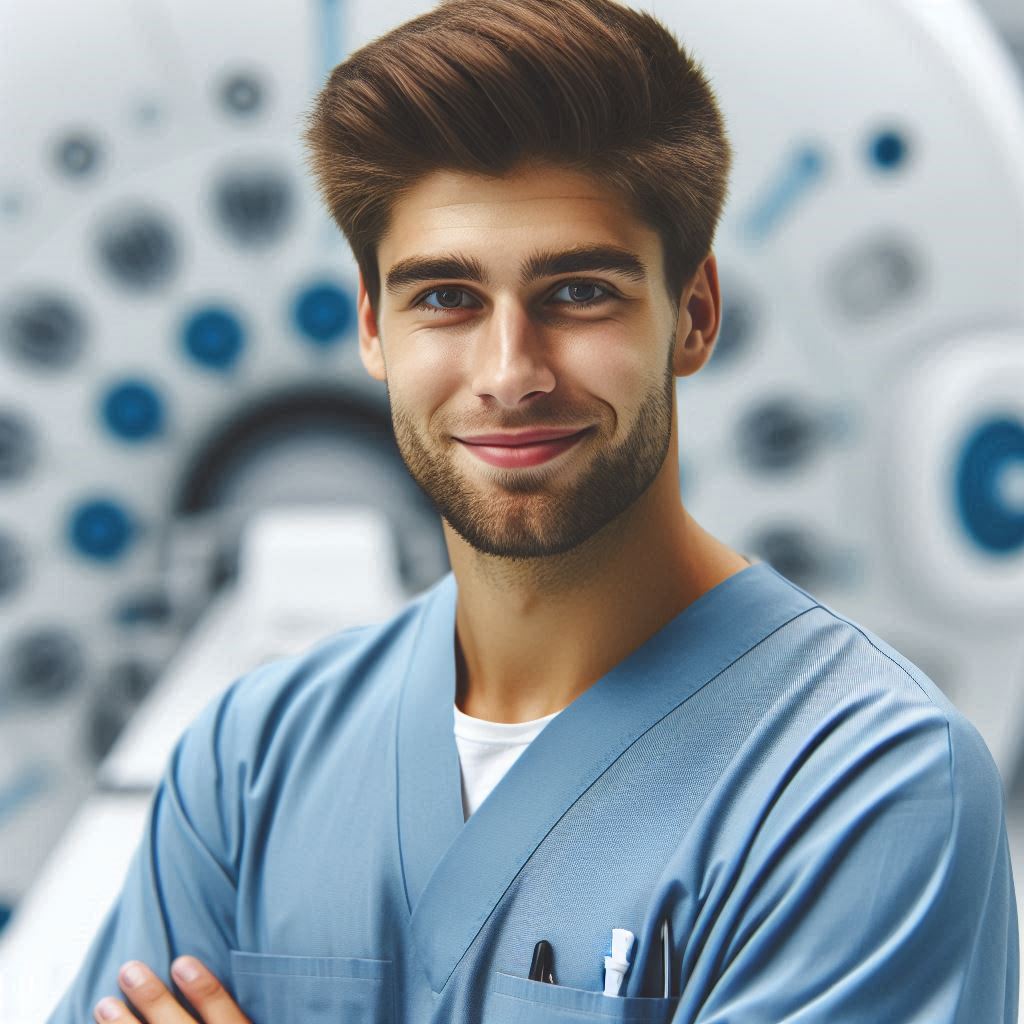Introduction
Technological tools are indispensable in the field of sleep technology.
These tools enable sleep technologists to perform their duties with greater accuracy and efficiency.
Advanced technology is essential for the accurate diagnosis and treatment of sleep disorders.
Polysomnography, a common sleep study, relies heavily on sophisticated equipment to measure various physiological parameters.
This technology records brain waves, oxygen levels, heart rate, and breathing patterns, providing comprehensive data for analysis.
By utilizing these advanced tools, sleep technologists can effectively monitor patients’ sleep cycles and identify potential issues.
Innovations such as CPAP machines and adaptive servo-ventilation devices are pivotal in treating conditions like sleep apnea.
These technological advancements significantly enhance patient care and outcomes.
Sleep technologists use the data from these tools to generate detailed reports essential for physicians’ treatment plans.
The integration of technology in sleep studies not only improves the precision of diagnoses but also increases the efficiency of the entire process.
For instance, automated scoring systems can quickly analyze sleep data, reducing the time required for manual scoring.
This allows sleep technologists to focus more on patient care and less on administrative tasks.
Furthermore, technological tools facilitate real-time monitoring, enabling immediate intervention if a patient experiences severe sleep disturbances during a study.
The Evolution of Technological Tools in Sleep Technology
As the field of sleep technology has advanced over the years, technological tools have played a crucial role in revolutionizing the way sleep disorders are diagnosed and treated.
These tools have not only improved the accuracy and efficiency of sleep studies but have also enhanced the overall patient experience.
Let’s explore the key advancements that have shaped the field of sleep technology
Advancements in Technology
- Introduction of Polysomnography (PSG): PSG was a major breakthrough in sleep technology as it allowed sleep technologists to monitor multiple physiological parameters during sleep, such as brain waves, eye movements, and muscle activity.
- Development of Portable Monitoring Devices: Portable devices like home sleep apnea tests (HSATs) have made it easier for patients to undergo sleep studies in the comfort of their own homes, reducing the need for overnight stays in sleep labs.
- Integration of Telemedicine: Telemedicine platforms have enabled sleep technologists to remotely monitor and interact with patients, providing real-time feedback and support for managing their sleep disorders.
Key Milestones in Technological Tools
- Automated Scoring Software: The introduction of automated scoring software has significantly reduced the time and effort required to analyze sleep study data, allowing sleep technologists to focus more on interpreting results and providing patient care.
- Continuous Positive Airway Pressure (CPAP) Devices: CPAP devices have become a cornerstone in the treatment of sleep apnea, providing a non-invasive method of maintaining an open airway during sleep and improving overall sleep quality.
- Smart Devices and Apps: Smart devices and mobile apps empower patients to track sleep patterns, monitor progress, and improve sleep hygiene for better health outcomes.
Technological tools in sleep technology continuously evolve, enhancing management and treatment of sleep disorders.
This paves the way for more personalized and effective patient interventions.
By embracing these advancements, sleep technologists can provide comprehensive care and support to individuals seeking solutions for their sleep-related concerns.
Types of Technological Tools Used by Sleep Technologists
When it comes to the field of sleep technology, there are several types of technological tools that sleep technologists use to assess sleep patterns and disorders.
These tools are essential in diagnosing and treating sleep-related issues, providing valuable data for healthcare professionals to analyze and interpret.
Let’s explore the various categories of tools used by sleep technologists
Polysomnography Machines
Polysomnography (PSG) machines are one of the primary tools used by sleep technologists to monitor and record various physiological parameters during sleep.
These machines typically measure brain waves, eye movements, muscle activity, heart rate, and respiratory patterns.
By analyzing this data, sleep technologists can diagnose sleep disorders such as sleep apnea, insomnia, narcolepsy, and restless leg syndrome.
Actigraphy Devices
Actigraphy devices are wearable devices that monitor movement and rest patterns to assess sleep-wake cycles.
These devices use accelerometers to track movements and provide data on sleep duration, efficiency, and quality.
Actigraphy devices are particularly useful in assessing circadian rhythms, insomnia, and other sleep-related disorders.
Sleep technologists can analyze this data to make recommendations for improving sleep quality and quantity.
Sleep Tracking Apps
Firstly, sleep tracking apps are software applications that provide insights into sleep patterns and habits.
These apps can monitor sleep duration, quality, and disturbances, as well as provide personalized recommendations for improving sleep.
Sleep technologists use sleep tracking apps alongside wearables or PSG machines to create comprehensive sleep profiles.
Sleep technologists can leverage this data to create tailored treatment plans for patients with sleep disorders.
Basically, technological tools play a crucial role in the practice of sleep technology.
Sleep technologists use polysomnography machines, actigraphy devices, and sleep tracking apps to assess sleep patterns and disorders accurately.
Sleep technologists can diagnose, treat, and monitor sleep-related issues effectively, improving patients’ sleep quality and health.
Read: Surgical Technologist Job Outlook: Demand and Opportunities
Benefits of Using Technological Tools in Sleep Technology
Technological tools have revolutionized the field of sleep technology, offering numerous benefits for both sleep technologists and patients.
These tools have enhanced the quality of sleep studies and have significantly improved patient care.
Let’s delve into the advantages of utilizing technological tools in sleep studies and patient care
Advantages of Utilizing Technological Tools in Sleep Studies
- Enhanced Data Collection: Technological tools allow for more accurate and comprehensive data collection during sleep studies. This leads to better diagnosis and treatment planning.
- Improved Monitoring Capabilities: These tools offer real-time monitoring of various sleep parameters, providing instant feedback to sleep technologists.
- Streamlined Workflow: The use of technological tools streamlines the workflow in sleep labs, making it easier for sleep technologists to manage multiple tasks efficiently.
- Remote Monitoring Options: Some tools enable remote monitoring of patients, allowing for continuous monitoring even outside the sleep lab setting.
- Integration with Electronic Health Records: Technological tools can be integrated with electronic health records, ensuring seamless documentation and easy access to patient information.
- Enhanced Collaboration: These tools facilitate collaboration among healthcare providers, enabling the sharing of data and insights for better patient outcomes.
Advantages of Technological Tools in Improving Patient Outcomes
- Increased Accuracy in Diagnosis: Technological tools help in the accurate identification of sleep disorders, leading to appropriate treatment interventions.
- Personalized Treatment Planning: With the use of these tools, sleep technologists can tailor treatment plans based on individual patient data, improving outcomes.
- Monitoring Compliance: Technological tools can track patient adherence to treatment regimens, ensuring better compliance and efficacy of treatments.
- Enhanced Patient Education: These tools allow for better visualization and explanation of sleep study results to patients, fostering understanding and adherence to recommendations.
- Improved Follow-up Care: By utilizing technological tools, sleep technologists can provide better follow-up care to patients, monitoring progress and making necessary adjustments.
- Increased Patient Satisfaction: Overall, the use of technological tools in sleep technology enhances the patient experience, resulting in higher satisfaction rates and improved outcomes.
Technological tools play a crucial role in the field of sleep technology, offering a wide range of benefits for both sleep technologists and patients.
These tools have transformed the way sleep studies are conducted and improved patient outcomes through enhanced data collection.
Embracing technological advancements in sleep technology is key to providing quality care and improving patient outcomes in the field of sleep medicine.
Read: Ultrasound Technician vs. Radiologic Technologist
Challenges and Limitations of Technological Tools in Sleep Technology
When it comes to utilizing technological tools in the field of sleep technology, sleep technologists face several challenges and limitations.
It is important to address these issues in order to enhance the effectiveness of sleep studies and improve patient outcomes.
Common issues faced by sleep technologists when using technological tools
- Compatibility issues: Technological tools may not always be compatible with existing software or hardware systems used in sleep labs.
- Complexity of tools: Some tools may be difficult to learn and use, leading to inefficiencies in data collection and analysis.
- Calibration problems: Ensuring that devices are properly calibrated for accurate measurements can be a challenge for sleep technologists.
- Data security concerns: Protecting patient data and ensuring compliance with privacy regulations can be a significant issue when using technological tools.
- Interpretation of results: Technological tools may provide vast amounts of data that can be overwhelming to analyze and interpret effectively.
Potential limitations of these tools and how to overcome them
- Training and education: Providing comprehensive training to sleep technologists on how to use technological tools effectively can help overcome complexity issues.
- Regular maintenance: Conducting routine maintenance and calibration checks on devices can ensure accurate measurements and reduce errors.
- Investing in compatible systems: Upgrading to tools that are compatible with existing systems in sleep labs can help alleviate compatibility issues.
- Data encryption and compliance: Implementing strong encryption protocols and ensuring compliance with data privacy regulations can address security concerns.
- Utilizing data analysis software: Implementing data analysis software that can streamline data interpretation can help sleep technologists make sense of complex results.
Sleep technologists optimize technological tools in sleep studies by acknowledging and addressing challenges and limitations.
This improves patient care for sleep disorders.
Read: The Role of Technology in Modern Sonography

Training and Education on Technological Tools for Sleep Technologists
Importance of Proper Training in Using Technological Tools Effectively
Proper training in using technological tools is vital for sleep technologists to perform their jobs effectively.
These tools are integral to diagnosing and treating sleep disorders, providing essential data that guide patient care.
Technologists may struggle to use these advanced devices correctly, risking compromised accuracy in studies and treatments.
Ensuring that sleep technologists receive comprehensive training on these tools is essential for maintaining high standards in sleep medicine.
Training programs must encompass a wide range of devices and software used in sleep technology.
These include polysomnography equipment, CPAP machines, oximeters, and various data analysis software.
Each tool requires specific knowledge and skills, which can only be acquired through structured training programs.
Moreover, understanding how to troubleshoot and maintain these devices is crucial, as any malfunction could disrupt the sleep study process and affect patient outcomes.
Recommendations for Educational Resources and Certification Programs in Sleep Technology
Educational resources for aspiring sleep technologists are abundant and varied.
Many community colleges and universities offer specialized programs in polysomnography and sleep technology.
These programs typically include coursework on the operation of sleep study equipment, patient care techniques, and data analysis.
Hands-on training is a significant component, allowing students to gain practical experience with the technological tools they will use in their careers.
Accredited programs ensure that students are well-prepared to meet the demands of the field and provide high-quality patient care.
Certification programs further enhance a sleep technologist’s expertise and credibility.
The BRPT widely recognizes the Registered Polysomnographic Technologist (RPSGT) credential in the industry.
Obtaining this certification demonstrates a technologist’s proficiency with the necessary tools and techniques.
To obtain certification, candidates must pass a comprehensive exam covering sleep technology aspects, including equipment use and data interpretation.
Maintaining certification also involves continuing education, ensuring technologists stay current with technological advancements and industry standards.
Read: Work Environment for Surgical Technologists: Hospitals vs. Clinics
Transform Your Career Today
Unlock a personalized career strategy that drives real results. Get tailored advice and a roadmap designed just for you.
Start NowFuture Trends in Technological Tools for Sleep Technologists
Sleep technology is continuously evolving, with new innovations and trends constantly emerging in the field.
As sleep technologists strive to provide better care and accurate diagnoses for patients with sleep disorders.
Here are some of the upcoming advancements that are projected to shape the future of sleep technology.
Predicted Innovations in Sleep Technology
- Artificial Intelligence (AI) Integration: AI algorithms are expected to enhance data analysis and interpretation, aiding sleep technologists in diagnosis and treatment planning.
- Wearable Devices for Sleep Monitoring: Advanced sensors and wearable technology will allow for continuous monitoring of sleep patterns and vital signs in real-time.
- Telemedicine for Sleep Consultations: Virtual sleep consultations using telemedicine platforms will make sleep healthcare more accessible and convenient for patients.
- Smart Beds and Mattresses: Technologically advanced beds and mattresses will be equipped with sensors to regulate sleep temperature and adjust firmness for optimal comfort.
- Sleep Tracking Apps: AI-powered mobile apps will analyze sleep data collected from wearables to provide personalized insights and recommendations for improving sleep quality.
Impact of Advancements on Sleep Technology
These projected advancements are poised to revolutionize the field of sleep technology in several ways
- Improved Accuracy in Diagnosis: AI algorithms can analyze large datasets with precision, leading to more accurate diagnoses of sleep disorders.
- Enhanced Patient Monitoring: Wearable devices will enable remote monitoring of patients’ sleep patterns, allowing for better tracking of treatment progress.
- Increased Accessibility to Care: Telemedicine platforms will break down geographic barriers, making it easier for individuals to seek sleep consultations from specialists.
- Personalized Treatment Plans: Data collected from smart beds and wearables can be used to tailor treatment plans to each patient’s specific needs and preferences.
- Empowerment Through Self-Management: Sleep tracking apps empower individuals to take control of their sleep health by providing actionable insights and guidance for improvement.
Essentially, the future of sleep technology holds promise for improving patient outcomes, enhancing diagnostic accuracy, and advancing the field of sleep medicine through innovative technological tools.
Conclusion
Technological tools are pivotal in enhancing the practice of sleep technology.
Advanced polysomnography equipment revolutionizes sleep technologists’ ability to diagnose and treat sleep disorders.
Sophisticated data analysis software enhances their diagnostic accuracy. Cutting-edge devices improve treatment strategies.
These tools provide precise and detailed data, enabling technologists to monitor and interpret sleep patterns with greater accuracy.
The integration of technology in sleep studies has improved diagnostic accuracy, leading to better treatment outcomes for patients.
These advanced tools enable sleep technologists to perform comprehensive sleep studies, effectively identifying and addressing various sleep disorders.
Innovations in technology have continuously improved the efficiency and effectiveness of sleep studies, making the role of a sleep technologist increasingly vital.
Staying updated with the latest technological advancements is crucial for sleep technologists.
This knowledge ensures they can provide the highest quality care and utilize the most efficient methods available.
Embracing new technologies streamlines workflows and enhances the patient experience.
This leads to more accurate diagnoses and better management of sleep disorders.
[E-Books for Sale]
The Big Book of 500 High-Paying Jobs in America: Unlock Your Earning Potential
$19.99 • 500 High-Paying Jobs • 330 pages
Explore 500 high-paying jobs in America and learn how to boost your career, earn more, and achieve success!
See All 500 High-Paying Jobs of this E-Book
1001 Professions Without a Degree: High-Paying American Jobs You Can Start Now
$19.99 • 1001 Professions Without a Degree • 174 pages
Discover 1001 high-paying jobs without a degree! Unlock career tips, skills, and success strategies for just $19.99!




